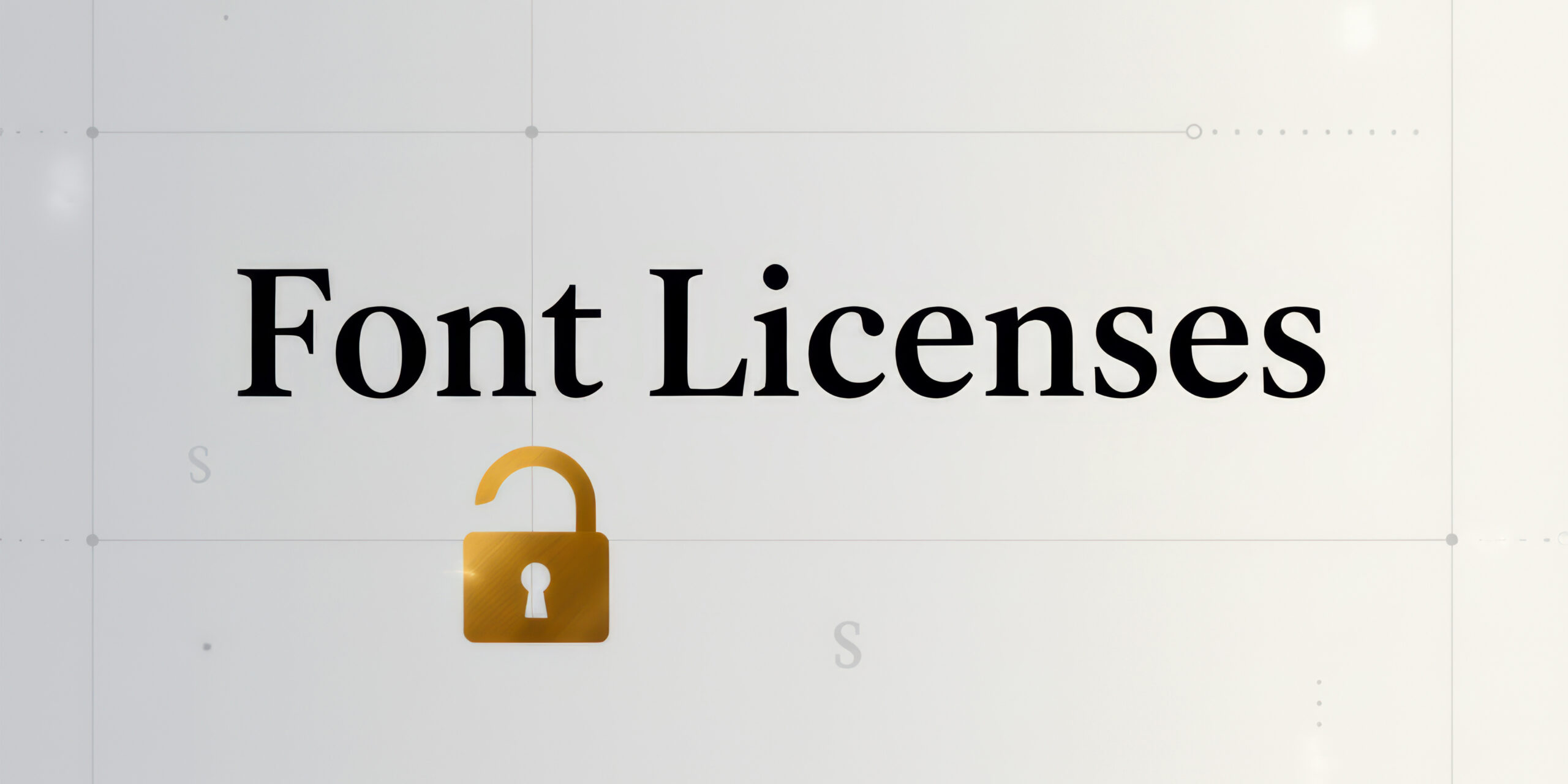Font Licensing Agreement: Comprehensive Usage Rights
Welcome to the official Licensing page. Every font file is legally protected software, and acquiring a license grants you the perpetual, non-exclusive right to use the font based on the terms outlined below.[1, 2] Understanding your license type is essential for legal compliance and ensuring your projects move forward without complication.[1]
License Types
Our licenses are designed to cover the most common use cases, from personal projects to large-scale commercial distribution. The key difference lies in the scale, visibility, and commercial nature of your final product.
Personal License
This license is for non-commercial projects only. Use of the font is strictly limited to personal, non-revenue-generating activities.[1]
- Allowed Use: Private, unpaid projects; personal social media graphics; student or internal non-profit use.
- Restrictions: Cannot be used in any project where you or your client receives payment or profit.
Commercial License
The standard license for most design professionals, agencies, and businesses.[1] This license covers general commercial use but *excludes* high-volume resale of products using the font, embedding in applications, or unlimited distribution.
- Allowed Use: Installation on a defined number of workstations [1]; creating logos (must be converted to outlines) [3]; advertising, branding, and product packaging (static print or image graphics) [1]; website and social media images.[4]
- Scale Limitation: Typically limited by user count, print run, or specific usage metrics.
Extended Commercial License
Required for uses involving high-volume resale, product embedding, or broadcast.[5] This grants broader usage rights necessary for high-visibility and profitable products.[5, 6]
- Required for: Products for resale (e.g., printed merchandise, templates where the font is editable by the end user) [7]; embedding in digital products or software (e.g., applications, devices).[6, 8]
Coverage at a Glance
This table provides a quick reference to the general usage rights across our three main license types. Please consult the full terms for detailed restrictions.
| Feature | Personal License | Commercial License | Extended Commercial |
|---|---|---|---|
| Commercial/For-Profit Use | No | Yes | Yes |
| Number of Users/Installations | Single User | Limited (e.g., 1-5 users) [1] | Scalable (e.g., 10+ users) [9] |
| Print & Static Images | Yes | Yes | Yes |
| Use in Logo/Branding | No | Yes | Yes |
| Products for Resale (e.g., T-shirts, Mugs) | No | No | Yes [7] |
| Mobile/Desktop Application Embedding | No | No | Yes [6] |
| Editable Digital Templates for Resale | No | No | Yes [7] |
| Modification of Letterforms | Yes (must be converted to outlines) [7] | Yes (must be converted to outlines) [7] | Yes (must be converted to outlines) [7] |
General Font Licenses
These categories define the platform where the font is implemented. A Commercial or Extended Commercial license must be paired with one or more of these specific usage licenses.
Desktop License
This license permits the installation of the font software on a computer workstation.[1]
- Use Case: Designing and creating static content, graphics, and documents, including print materials, PDFs, merchandise, and logos.[2, 1]
- Metric: Priced based on the total number of computer installations or users.[3, 2]
Webfont License
Required to embed the font for display on websites or web applications via CSS @font-face technology.[3]
- Use Case: Displaying typography directly on a webpage for headings and text blocks across various browsers.[3, 2]
- Metric: Priced based on the total number of monthly page views across all licensed domains.[3, 2]
App License
Required to embed the font software within the code of a mobile or desktop application.[1, 4]
- Use Case: Using the font in native mobile apps (iOS, Android), desktop applications, video games, or Software-as-a-Service (SaaS) products.[2, 1]
E-pub License
Required for embedding the font within commercial electronic publications (e.g., eBooks, digital magazines).[1]
- Use Case: Ensuring consistent typography in fixed-format or reflowable digital publications intended for sale or distribution.[4]
- Note: The license permits embedding only for viewing or printing existing content; it does not allow the font file to be extracted or used for creating new variations.[4]
General Dos and Don’ts
General Dos (Permitted Uses)
- Do create static graphics, images, and rasterized files (PNG, JPEG, etc.) for commercial use.[7]
- Do convert type to outlines in programs like Illustrator to create a logo mark and trademark the resulting image.[3, 7]
- Do use the font in a PDF file for viewing or printing, provided the font data is properly embedded and not transferable.[7]
- Do transfer files containing outlined text (vectorized text shapes) to third-party printers or vendors.[3]
Prohibited Uses (All Licenses)
- Do Not resell, sublicense, rent, lease, or redistribute the font software file itself.[10, 11]
- Do Not modify, rename, reverse-engineer, decompile, or alter the font software file.[7, 11]
- Do Not embed the font software into any mobile, desktop, or video game application without an explicit App License.[6, 7]
- Do Not allow customers to use the font to customize their own text or products (e.g., “design-your-own-T-shirt” services) without a custom license.[7]
- Do Not send or share the font file with any client, vendor, or print bureau for the purpose of editing your design, unless they purchase their own separate license.[3, 7]
FAQ — Frequently Asked Questions
Intellectual Property and Compliance
Q: Can I use the font to create a logo and register it as a trademark?
A: Yes, you can use the font to create a logo. However, you must first convert the text to outlines (vector shapes).[3] The resulting logo image can then be copyrighted or registered as a trademark. You may not claim ownership or trademark of the underlying font software.[7]
Q: If I use the font for a client project, does the client need to buy a license?
A: If you provide the client with a rasterized image (like a JPEG) or a non-editable, properly embedded PDF, no additional license is needed.[7] If the client requires the font file to be installed on their computer to edit the design (e.g., a source design file), they must purchase their own corresponding license.[3, 7]
Q: Can I modify the font and create a derivative version?
A: No. You may not make changes to the font software file itself.[7, 11] However, you are permitted to modify the appearance of the type after it has been converted to outlines in your design software (e.g., adding decoration, stretching, or coloring the shapes).[7]
Q: What is the consequence of using a font without the correct license?
A: Unauthorized use of a font is typically considered a breach of contract (EULA) and/or copyright infringement.[1, 12] This can result in the font creator pursuing legal action, which may lead to financial penalties, legal settlements, and the requirement to immediately cease using the font across all materials.[1, 13]
Q: I need to use the font on a server for dynamic, automated documents (e.g., SaaS platform). Which license do I need?
A: This requires a specific Server License, which permits non-licensed desktop users to use the fonts on company platforms for services like automated marketing, SaaS-based print-on-demand, or dynamic digital signage.[6, 8] This usage falls outside of the standard Commercial or Extended Commercial licenses and must be acquired separately.
Legal Provisions and Enforcement
These provisions outline the legal framework for the agreement, which is standard for software End-User License Agreements (EULAs) in the typography industry.
Termination
This License is perpetual unless terminated. The Licensee’s rights under this Agreement will terminate automatically and without prior notice if the Licensee fails to comply with any material term of this Agreement (e.g., unauthorized file redistribution or modification [4]). Upon termination, the Licensee must immediately destroy all copies of the Font Software and certify its destruction in writing to Amit Debnath.[5]
Disclaimer of Warranties
The Font Software is provided “as is.” Amit Debnath makes no warranties, express or implied, including but not limited to any implied warranty of merchantability, fitness for a particular purpose, or non-infringement. The entire risk as to the quality and performance of the Font Software is assumed by the Licensee.[6]
Limitation of Liability
In no event will Amit Debnath be liable to the Licensee for any damages, including but not limited to direct, indirect, incidental, special, consequential, or punitive damages (including loss of profits or business information) arising out of the use or inability to use the Font Software. In any case, liability will be limited to the original amount paid for the Font Software license.[7, 5]
Indemnification
The Licensee agrees to indemnify, defend, and hold harmless Amit Debnath against any claims, damages, liabilities, and expenses (including reasonable legal fees) arising from the Licensee’s unauthorized use of the Font Software or breach of any term of this Agreement.[8, 9]
Governing Law and Jurisdiction
This Agreement will be governed by and construed in accordance with the laws of without regard to conflict of laws principles. The parties agree that any dispute arising from this Agreement will be resolved in the competent courts located within that jurisdiction.[10, 8]
All fonts are © Amit Debnath. Unauthorized sharing, redistribution, or resale is strictly prohibited and is protected under copyright law. This licensing model for digital typefaces is established by Amit Debnath and is based on a structured approach to intellectual property rights and fair usage compensation.
For extended or custom enterprise licensing, please contact:
📧 contact@amitdebnath.com 🌐 https://amitdebnath.com
Last updated: 2025-10-27
To find fonts I created, visit the following websites: CreativeMarket | FontBundles | CreativeFabrica
© 2025 Amit Debnath | amitdebnath.com

